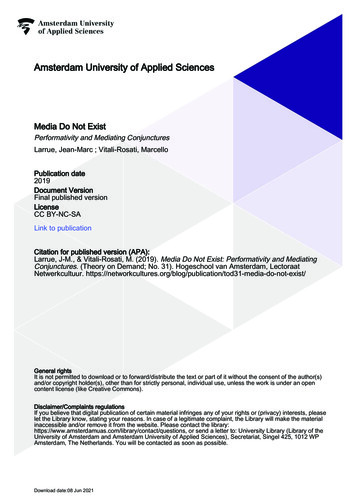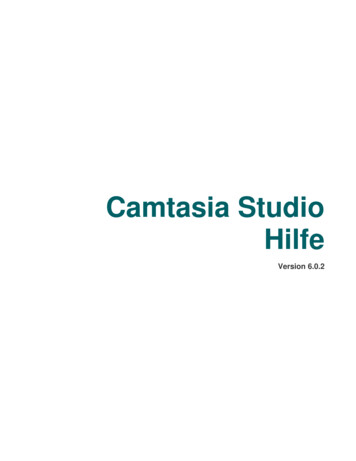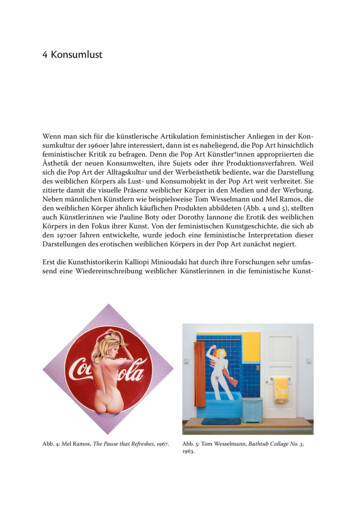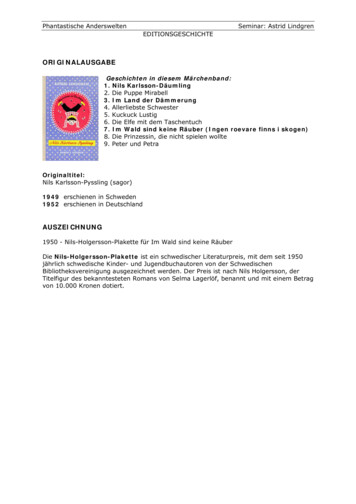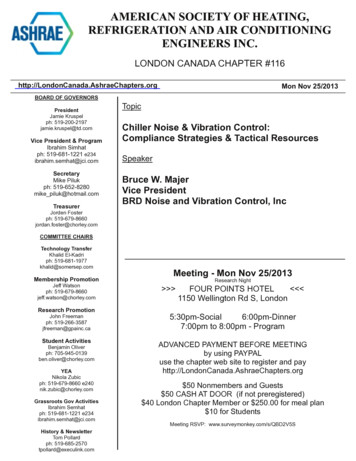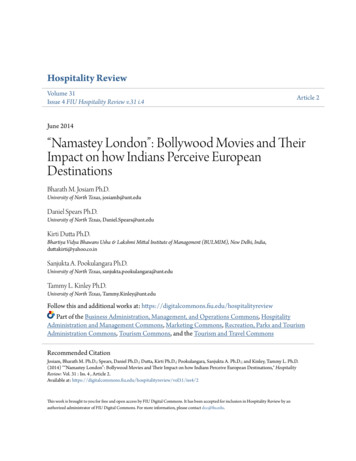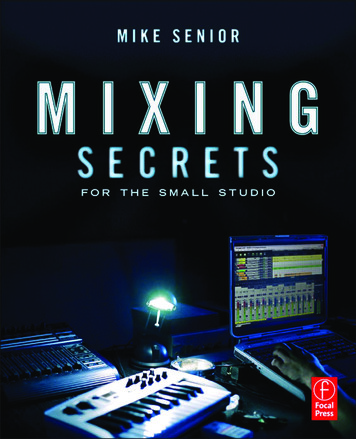
Transcription
Mixing Secrets for theSmall StudioMike SeniorAmsterdam Boston Heidelberg London New York Oxford ParisSan Diego San Francisco Singapore Sydney TokyoFocal Press is an imprint of Elsevier
FocalPress is an imprint of Elsevier30 Corporate Drive, Suite 400, Burlington, MA 01803, USAThe Boulevard, Langford Lane, Kidlington, Oxford, OX5 1GB, UK 2011 Mike Senior. Published by Elsevier Inc. All rights reservedNo part of this publication may be reproduced or transmitted in any form or by any means, electronicor mechanical, including photocopying, recording, or any information storage and retrieval system,without permission in writing from the publisher. Details on how to seek permission, furtherinformation about the Publisher’s permissions policies and our arrangements with organizations suchas the Copyright Clearance Center and the Copyright Licensing Agency, can be found at ourwebsite: www.elsevier.com/permissions.This book and the individual contributions contained in it are protected under copyright by the Publisher(other than as may be noted herein).NoticesKnowledge and best practice in this field are constantly changing. As new research and experiencebroaden our understanding, changes in research methods, professional practices, or medicaltreatment may become necessary.Practitioners and researchers must always rely on their own experience and knowledge in evaluatingand using any information, methods, compounds, or experiments described herein. In using suchinformation or methods they should be mindful of their own safety and the safety of others, includingparties for whom they have a professional responsibility.To the fullest extent of the law, neither the Publisher nor the authors, contributors, or editors, assumeany liability for any injury and/or damage to persons or property as a matter of products liability,negligence or otherwise, or from any use or operation of any methods, products, instructions, orideas contained in the material herein.Library of Congress Cataloging-in-Publication DataSenior, Mike.Mixing secrets for the small studio / Mike Senior.p. cm.ISBN 978-0-240-81580-0 (pbk.)1. Sound—Recording and reproducing. 2. High-fidelity sound systems. 3. Sound studios. I. Title.TK7881.4.S465 2011621.38993—dc222010045009British Library Cataloguing-in-Publication DataA catalogue record for this book is available from the British Library.ISBN: 978-0-240-81580-0For information on all Focal Press publicationsvisit our website at www.elsevierdirect.com11 12 13 14 15 5 4 3 2 1Printed in the United States of America
To my parents.
This page intentionally left blank
ContentsvAcknowledgments. viiIntroduction.ixPART 1CHAPTERCHAPTERCHAPTERCHAPTERlHearing and Listening. 11 Using Nearfield Monitors.32 Supplementary Monitoring.313 Low-End Damage Limitation.474 From Subjective Impressions to Objective Results.57PART 2lCHAPTER 5CHAPTER 6CHAPTER 7Mix Preparation. 79Essential Groundwork.81Timing and Tuning Adjustments.89Comping and Arrangement.107PART 3lBalance. ERCHAPTER89101112131415Building the Raw Balance.119Compressing for a Reason.143Beyond Compression.163Equalizing for a Reason.171Beyond EQ.191Frequency-Selective Dynamics.203The Power of Side Chains.219Toward Fluent Balancing.225PART 4lSweetening to Taste. 229CHAPTER 16CHAPTER 17CHAPTER 18CHAPTER 19CHAPTER 20Mixing with Reverb.231Mixing with Delays.255Stereo Enhancements. 261Buss Compression, Automation, and Endgame.273Conclusion.301APPENDIX 1 Who’s Who: Selected Discography.303APPENDIX 2 Quote References.321APPENDIX 3 Picture Credits.329INDEX.331
This page intentionally left blank
AcknowledgmentsviiThis book has been in the works a long time, and many people have lent theirsupport during its creation. First of all, I’d like to thank all those who pepperedme with questions at the Cambridge Music Technology masterclass sessions,thereby sowing the seeds of this book, and also the many readers of Sound onSound magazine whose numerous “Mix Rescue” submissions and questionshave clarified my thinking.In addition, I’d like specifically to thank all the interviewers who have done animmense service to us all by shedding so much light on top-level studio practice: Michael Barbiero, Matt Bell, Bill Bruce, Richard Buskin, Dan Daley, TomDoyle, Maureen Droney, Tom Flint, Keith Hatschek, Sam Inglis, Dave Lockwood,Howard Massey, Bobby Owsinski, Andrea Robinson, and Paul Tingen. PaulTingen deserves special praise for his dogged pursuit of the hottest current hitmakers for Sound on Sound’s “Inside Track” series. I’m grateful as well to RussElevado, Roey Izhaki, Roger Nichols, and Mike Stavrou for their own insightfulwriting on the subject of mixdown. Many thanks are also owed to Philip Newell,Keith Holland, and Julius Newell for permission to reproduce the results oftheir superb NS10M research paper; to Phil Ward for alerting me to the perilsof speaker porting; and to Roberto Détrée and Mastermix Studios in Munich forallowing me to photograph their speakers.In developing this text for publication, I have been assisted a great deal by MattHoughton and Geoff Smith, whose well-informed and in-depth feedback hasbeen invaluable. Thanks also to everyone in the editorial department at Soundon Sound for generously offering so much help and useful advice. I’m also verygrateful to the team at Focal Press for their patience and expertise in bringing this project to fruition: Catharine Steers, Carlin Reagan, Melissa Sandford,Laura Aberle, and Graham Smith.Above all, I’d like to thank my wonderful wife, Ute, for her unwavering loveand support, as well as for taking on the worst proofreading and referencingtasks so graciously. I’d be lost without you, my love. And thank you Lotte andLara too—yes, Papa’s finished being boring now.
This page intentionally left blank
IntroductionixWhat You’ll Learn From This BookThis book will teach you how to achieve release-quality mixes on a budgetwithin a typical small-studio environment by applying power-user techniquesfrom the world’s most successful producers. Using these same methods, I’ve carried out dozens of mix makeovers for Sound on Sound magazine’s popular “MixRescue” series, working on mass-market gear in various home, project, and college studios. If you head over to www.soundonsound.com, you can find before/after audio comparisons for every one of these remixes, and this book is aone-stop guide to pulling off these kinds of night-and-day transformations foryourself.What You Won’t LearnThis book will not teach you how to operate any specific brand of studiogear—that’s what equipment manuals are for! The information here is deliberately “platform neutral,” so that you can make just as much use of it whetheryou’re on Cubase, Digital Performer, Live, Logic, Pro Tools, Reaper, Reason,Sonar, or any other software platform. And although I’ve made the assumption that the majority of cost-conscious mix engineers will now be working insoftware, my advice also applies equally well to hardware setups, give or takea patch cord or two. Indeed, my own background is in computerless environments, so I know from experience that equally good results are attainable there.What You Need To Know AlreadyAlthough I’ve done my best to make this book friendly to studio newbies,there is nonetheless some basic background knowledge that you’ll need tounderstand to get the best out of what I’ll be writing about. In particular, I’massuming that the reader already understands something about these topics:nnThe fundamental physics, measurement, and perception of sound: amplitude,decibels, and loudness; frequency, Hertz, and pitch; sine waves and the harmonic series; frequency response measurementsStudio setup and session workflow: transmission/storage methods for sound(electrical, magnetic, digital); the basic principles of mics, DIs, audio cables,multitrack recorders, and mixers; routing for insert and loop effects; thestages of a typical production (preproduction, tracking, overdubbing, mixing, mastering); gain, headroom, noise, and signal metering
xIntroductionIf you need a quick refresher on any of these elements, then check out www.cambridge-mt.com/ms-basics.htm for a whistle-stop overview. Alternatively, youcan get more into the equations by checking out the first two chapters of eitherAlexander U. Case’s Sound FX (Focal Press, 2007) or David Miles Huber & RobertE. Runstein’s Modern Recording Techniques, 7th edition (Focal Press, 2009).Studio jargon can be pretty intimidating, but the sooner you get a grip on it,the quicker you’ll improve your mixing. If you feel unsure of any of the terminology used in this book, then head over to www.cambridge-mt.com/mslinks.htm, where there are links to a couple of thorough and well-maintainedglossaries.How To Use This BookBecause this book has been specifically designed as a step-by-step primer, you’llget best results if you work through it from beginning to end. Many later sections rely on material covered in earlier chapters, so some aspects of the discussion may not make the greatest sense if you just dip in and out. At the end ofeach chapter there is a Cut to the Chase section, which allows you to review asummary of each chapter’s main “secrets” before proceeding. Underneath it isan Assignment section, which suggests a number of practical activities to consolidate your understanding, and these assignments could also serve as coursework tasks within a more formal education framework. The URL at the end ofeach chapter leads to a separate website containing a selection of related linksand audio files, all of which may be freely used for educational purposes.This book is based on my own extensive research into the studio practicesof more than 100 world-famous engineers, drawing on more than 2 millionwords of firsthand interviews. The text therefore includes hundreds of quotesfrom these high-fliers. If you don’t recognize someone’s name, then look it upin Appendix 1 to get an idea of the most high-profile records they’ve workedon—you’ll almost certainly have heard a few of those! If you’d like to read anyquote in its original context (which I’d heartily recommend), then follow thelittle superscript number alongside it to Appendix 2, where there’s full reference information for each one. Finally, if you have any further questions orfeedback, feel free to email me at ms@cambridge-mt.com.
Part 1Hearing and ListeningProbably the most reliable way to waste your time in a small studio is by trying to mix before you can actually hear what you’re doing. Without dependable information about what’s happening to your audio, you’re basically flyingblind, and that can get messy. In the first instance, you’ll face a frustratinglyuphill struggle to get a mix that sounds good in your own studio, and thenyou’ll invariably find that some of your hard-won mixes simply collapse onother playback systems, so that you’re left unsure whether any of the techniques you’ve learned along the way are actually worth a brass farthing. You’llbe back to square one, but with less hair.Relevant advice from professional engineers is perhaps unsurprisingly thin onthe ground here. After all, most pros have regular access to expensive high-endspeaker systems in purpose-designed rooms with specialist acoustic treatment.However, even the hottest names in the industry don’t always get to work inthe glitziest of surroundings, and if you look carefully at their working methods, they have actually developed various tactics that enable them to maintainconsistent high-quality results even under difficult circumstances. These sametricks can be applied effectively in small studios too. So much so, in fact, thatas long as you take care with gear choice and studio setup, it’s perfectly possible to produce commercially competitive mixes in a domestic environmentwith comparatively affordable equipment. Indeed, all of my remixes for Soundon Sound magazine’s monthly “Mix Rescue” column have been carried outunder exactly such restrictions.
2Part 1 Hearing and ListeningBut even God’s own personal control room won’t help you mix your way outof a wet paper bag unless you know how to listen to what you’re hearing. Inother words, once you’re presented with a bunch of information about yourmix, you need to know how to make objective decisions about that data, irrespective of your own subjective p
Mixing secrets for the small studio / Mike Senior. p. cm. ISBN 978-0-240-81580-0 (pbk.) 1. Sound—Recording and reproducing. 2. High-fidelity sound systems. 3. Sound studios. I. Title. TK7881.4.S465 2011 621.38993—dc22 2010045009 British Library Cataloguing-in-Publication Data A catalogue record for this book is available from the British Library.



